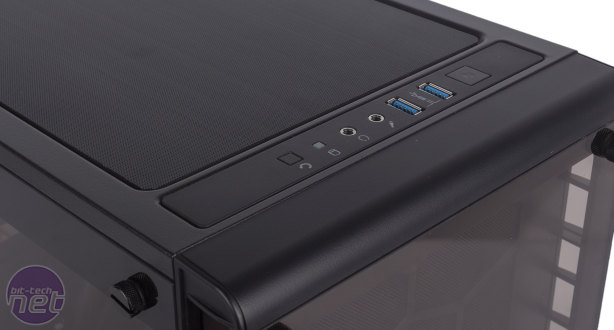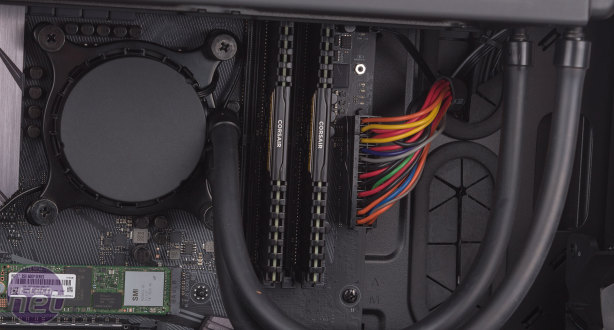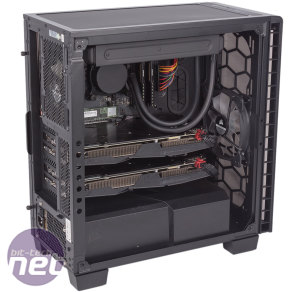
Performance Analysis
The most interesting element of performance is obviously the graphics side, and we were pleased to see some fairly solid scaling. Compared to the single Sapphire RX 480 Nitro+ OC in our GPU test system (not an exact comparison, but close enough for a general sense), we see 77 and 68 percent higher frame rates with this system at 1440p and 4K respectively in the DirectX 11 title, Fallout 4. 3DMark Fire Strike (1080p, DX11) improves by 58 percent, while Fire Strike Extreme (1440p, DX11) is better by 71 percent. In each of these DirectX 11 tests, it is either as good as or faster than a heavily overclocked GTX 1070, although you'd hope so given the cost of these two cards is about £570. Performance in these tests is close to that of an overclocked GTX 1080, but not quite as good. Consequently, the DinoPC C3 Mod Gaming PC (overclocked GTX 1080 with a 4.8GHz Core i7-7700K) is also ahead.Performance in DirectX 12, however, is even better. In Deus Ex: Mankind Divided, the average frame rate is 70 percent better at 1440p, and amazingly it more than doubles at 4K (newer drivers, different test system, and different RX 480s are the likely explanation of this). In this game, the average frame rate is higher than that of a fast GTX 1080, and at 4K the minimum is as well, although it's still just shy of 30fps. Still, if you can live with high instead of ultra settings, we'd happily describe this system as 4K-capable. The DirectX 12 3D Mark Time Spy test shows scaling over 70 percent too, and again the score beats a GTX 1080 OC. As such, the score is neck and neck with the £300 more expensive DinoPC system. In short, the dual RX 480 8GB setup is very promising for high-resolution DirectX 12 gaming titles.
In VR, however, it's not as strong. The score in VRMark is not much higher than with a single RX 480 8GB, and a GTX 1080 and the DinoPC system score far higher. That said, the Titan Osprey still comfortably meets VR requirements, more than doubling the score required for Oculus Rift suitability. Still, a GTX 1070 or GTX 1080 seems like your best bet if VR is a big priority for you.
The PCMark 8 results are as expected from a 4.9GHz Core i5-7600K – it was always going to do well in day-to-day tasks, including heavier ones like video transcoding. Rendering, however, makes the argument for upgrading to the hyper-threaded Core i7-7700K (or even X99), as the Cinebench and Terragen 4 scores show.
Storage performance is indeed capped, as predicted. In fairness, it's not by much: The 512GB 600P M.2 SSD is rated as having a maximum sequential read speed of 1,775MB/sec, but the PCI-E 3.0 x2 setting on the M.2 port limits it to just under 1,400MB/sec. The maximum write speed is unaffected: It's rated at 560MB/sec, and we saw 585MB/sec. Even so, the faster SM961 SSD and full four lanes in the DinoPC system see it shave a fair few seconds off the PCMark 8 storage trace results that this system achieves.
Nvidia still holds the GPU efficiency crown, as shown by the power consumption figures. 550W isn't especially high, but it's still 130W above a GTX 1080 system that will be faster in many games. Still, the 750W PSU never sounded like it was straining.
Idle, the system is very quiet. The pump is fixed at a fairly low 1,500 RPM according to the motherboard readout, the CPU fans spin at just 500 RPM, both case fans are quiet, and the GPU fans stay off completely. Even under load, things are very well managed. The CPU never went above 70°C, and the two Noiseblocker fans remained very quiet despite spinning up a bit faster to cope. The top GPU did reach its thermal limit of 90°C, but the cooler wasn't whiny or too loud (fans at 50 percent; about 2,100 RPM), nor did it throttle too much, averaging around 1,250MHz out of a maximum 1,310MHz. The secondary GPU, meanwhile, stayed cool (peak 66°C) and very quiet, with its fans hitting just 40 percent (about 1,500 RPM) and clock speeds staying nice and high at roughly 1,280MHz. We're pretty confident that even in a multi-hour gaming session on a warm day, noise and throttling would not be very significant at all with this system.
Conclusion
This is one very impressive system. Dual-GPU setups always risk being noisy, but OcUK has ensured that there's enough airflow and spacing here and has used cards with massive coolers to help keep things running smoothly. The CrossFire setup demonstrates plenty of merit in DirectX 12, battling and sometimes even beating pricier GTX 1080-based systems, although DirectX 11 and VR seem to favour the single Nvidia GPU. Build quality is also excellent, with solid cable routing and clean looks complemented by the tempered glass panels and the Aura-enabled motherboard, graphics cards and LED strip, which are sensibly all set to red to match the front fan. There are no poor hardware choices, and aesthetically the only niggles are the green SSD PCB and the visible 24-pin mainboard power cables, both of which are very minor and difficult to notice through the glass and lighting anyway.The pricing is also good. We worked out the rough cost of building this system yourself to be about £1,740, so you're looking at a £60 premium or so, which certainly seems fair given the build quality and the extremely generous warranty terms. Again, OcUK is offering a full three-year warranty, covering parts, labour, and shipping, putting it at a real advantage in this growing market. The incorrect BIOS setting for the PCI-E x4 SSD is the only thing keeping this system back from our top award. We have full confidence it will be rectified going forwards, too, so if you're shopping for a system in the £1,500 to £2,000 price bracket, this is an excellent place to start.


MSI MPG Velox 100R Chassis Review
October 14 2021 | 15:04












Want to comment? Please log in.